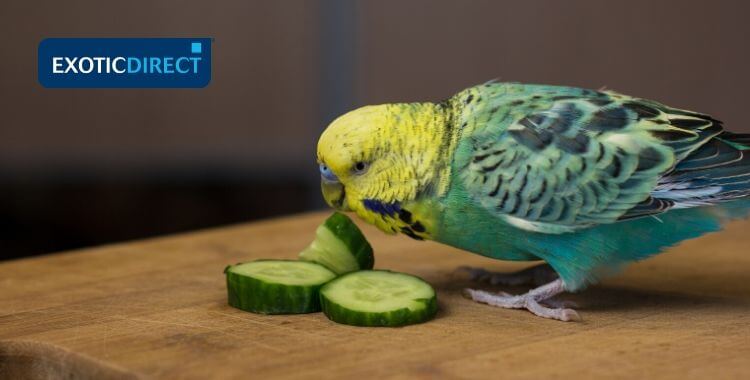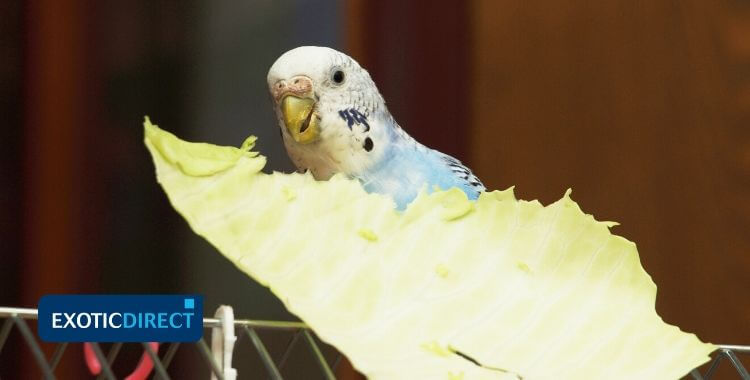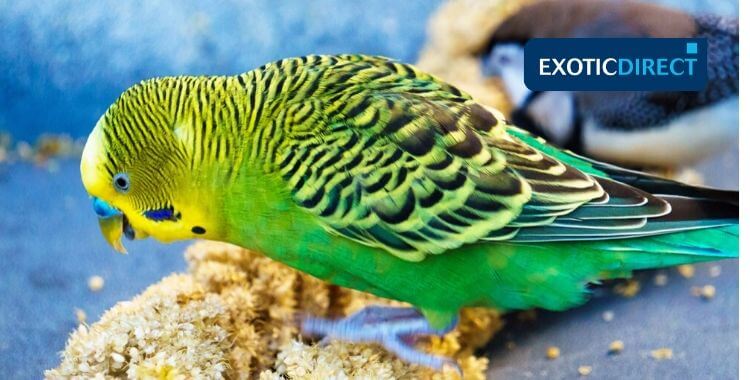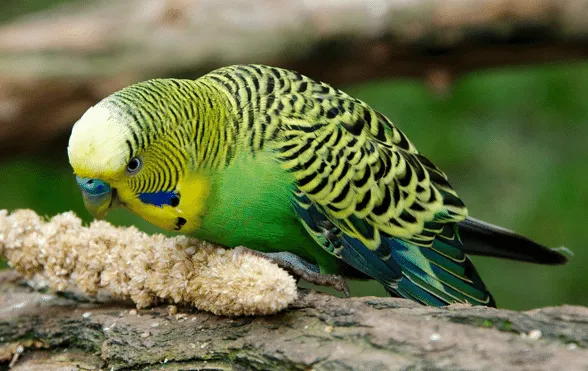Wild budgerigars are ground feeding seed and grass feeders. Grains and grasses provide the bulk of their intake in the wild. They move in flocks often thousands in number and fly enormous distances in their native Australia.
Get a quote to insure your budgie for £1,500 of vet fees | Up to three birds per policy | We’ve been insuring exotic pets since 1996 | Check out our customer reviews on Feefo
Advertisement: Northern Parrots have lots of tasty food for your Budgie. Visit now.
Up until a few decades ago, it was customary to feed budgies mostly on seed mixes, Trill being the favourite with a cuttlefish bone clipped to the cage bars, maybe a spray of millet as a treat. And that was it.
These days pellets have become the choice of many vets and you will have to choose whether pellets or seeds or your own mix will form the major part of the diet.
Current feeding advice is that 40% of the diet should be fresh foods. Choosing the correct food needs plenty of research and advice from trusted sources.
What fruit can budgies eat?
Budgies can eat banana, strawberries, apples, grapes, oranges, peaches, blueberry, pear, raisins, mango, melon (all varieties), nectarines, cherries (ensure you’ve removed the stone) and kiwis. Tropical fruits are also a favourite.
- What salad vegetables can budgies eat?
- What vegetables can budgies eat?
- Food and drink budgies can’t have
- Pellets or seed mix
- What seeds can budgies eat?
- Calcium for budgies
- What do baby budgies eat?
- How much should you feed a budgie?
- How often should you feed a budgie?
What salad vegetables can budgies eat?
You may like to offer small portions of: Cucumber, lettuce, beetroot, tomato, rocket, celery and pepper.
 Budgies enjoy cucumber along with other salad vegetables
Budgies enjoy cucumber along with other salad vegetables
What vegetables can budgies eat?
Budgies can eat: Green beans, carrot, peas in pods, cabbage, cauliflower, sweet corn and sweet potato – this should lightly cooked and your budgie would only want a teaspoon full.
There is controversy that onions, mushroom and garlic should be avoided. Some of us have used them successfully. Others do not. It is true that often a food stuff like parsley or fruit pips if taken in large amounts can cause harm but not in small amounts. Unless your fresh food is home grown or organic, it’s a useful precaution to wash well.
Food and drink budgie’s can’t have
You should avoid letting your budgie eat: Fried food, salt, crisps, bacon, coffee and caffeinated tea, although herbal teas are fine, biscuits, pastries, alcohol, cakes, chocolate, pizza, chips, bread, vanilla, peanut butter and cheese.
These foods aren’t that wonderful for humans either 😊. But most parrots, like toddlers with junk food, adore these human foods. The solution is to try to have unsuitable food out of sight.
If she’s out of her cage, don’t beat yourself up if a tiny bit of cookie or a chip was stolen or offered. Our family meals improved a lot, once we had free ranging parrots around at meal times.
 This budgie is enjoying a piece of cabbage
This budgie is enjoying a piece of cabbage
Pellets or seed mix
Pellet diets for captive birds originated in USA. Avian vets nowadays recommend pellets because a good pellet is considered to provide nutrients, minerals and vitamins that an amateur cannot match.
Seeds contain too much fat and lack other ingredients for health, so vets choose pellets. Several manufacturers produce pellets designed for budgerigars and other small birds.
The nugget shaped pellets are made from grains and vegetables and easily digestible. The formula is fortified with essential minerals and vitamins that will meet your budgie’s various needs better than an all seed diet.
A well-chosen pellet is a sensible choice for budgies, canaries, and finches. If you choose a pellet be sure it contains no artificial preservatives and buy in a small quantity.
A useful serving for a budgie would be one tablespoon a day, with the rest of the diet made up of fresh food. Usually around a thumbnail amount.
If your bird was not weaned onto pellets but onto a seed-based diet you can accustom her to the change by gradually substituting the food she’s currently eating with the food you want her to eat. It can be done with patience.
If you are feeding seeds, and don’t wish to switch, you can provide sprouts and seeds for 40-60% of her diet and a varied selection of fresh foods for the rest.
What seeds can budgies eat?
Most budgie owners buy a ready-made seed mix to feed their birds, which is fine as long as you are sure the seeds are fresh as they have a limited shelf life. Once past their sell by date the food has little nutritional value.It’s easy to test if seeds are fresh. Soak some seeds overnight. Rinse and drain them and spread out on wet cotton wool or kitchen paper and keep them warm for 24 hours.
If less than 50% of the seeds start to sprout throw them away. At least 90% of good seeds will sprout.
 Seeds can make up between 40-60% of your budgies diet, with fresh vegetables and fruit being the rest
Seeds can make up between 40-60% of your budgies diet, with fresh vegetables and fruit being the rest
Grass seeds for Budgies
Grass and grains are in the same category and make up 50% of your birds intake. They are the budgie’s staple food in the wild.
If you have a garden or access to open spaces here are some grasses that you can forage for free and feed the budgies.
Your budgie will pick out the seeds from the grass you give her.
- Annual meadow-grass (Poa annua)
- Meadow foxtail (Alopecurus pratensis)
- Orchard grass, aka cock’s-foot grass (Dactylis glomerata)
- Perennial ryegrass (Lolium perenne)
- Poverty brome, aka barren or sterile brome (Bromus sterilis)
- Rough bluegrass (Poa trivialis)
- Soft brome, or soft chess (Bromus hordeaceus)
- Velvet grass (Holcus lanatus)
- Timothy grass (Phleum pratense)
- Yorkshire Grass, aka Meadow soft grass, velvet grass or tufted grass (Holcus lanatus)
Budgie grains
You can feed your budgie these grains: Amaranth, barley, buckwheat (whole), canary seed, oats, quinoa, rye, sweetcorn kernels and wheat.
Budgie herb seeds
Herb-derived seeds can form a quarter of a good seed mix. You can store herbs in sealed jars and give a varied selection of the following: Alfalfa, cabbage, chia, clover, dill, fennel, fenugreek, kale, mustard (yellow, red and black), radish, red clover, groundsel and coriander leaves.
Budgie seeds that are high in fat
Parrots love many seeds that are bad for them. The following seeds need to be used sparingly because of their high fat content: Sunflower, flax, hemp, millet, niger, pumpkin (soaked and allowed to germinate first), rapeseed and sesame.
Millet, hemp, niger and rape are actually grains but they’re included here due to their high fat content.
Budgies in particular – like Galahs or some Amazons – can become obese and this shortens their life spans.
Budgie legumes
Peas and beans are high protein foods. They can be detrimental if fed in too large amounts as they can be a trigger for hormonal behaviour. If you use one or two sprouted legumes in a homemade seed mix that should be fine.
These are suitable for budgies but do not ever feed raw:
- Chickpeas
- Black-eyed peas
- Green peas
- Lentils (yellow, green, black NOT split)
- Mung beans
- Yellow peas
What is the best source of calcium for budgies?
Cuttlefish bones are the best source of calcium under normal circumstances. Parrots love to gnaw on the cuttlefish bone and it provides a great deal of enjoyment – far more than a couple of drops of calcium added to water or moist food.
If your birds are breeding you may need to use additional calcium in the form of supplements, although you always need to be careful not to over feed vitamins and minerals.
Budgies and drinking water
Many carers prefer bottled water. Also, the addition of a few drops of cider vinegar is a choice for many. The most important consideration is providing fresh water daily and more often in hot weather or aviary conditions.
Budgies – mealworms, chicken and egg
If you want to add an occasional treat some budgies adore dried or live mealworms. Although with a pelleted diet a budgie will be getting enough protein.
Also an occasional bite of hard-boiled eggs or a fragment of chicken or meat can be offered one or twice a week. Remember that small amounts should be given.
What do baby budgies eat?
Here’s a suitable recipe from the excellent Omlet website. You would not need it in everyday care but it’s helpful for young birds, breeding birds, moulting birds and unwell birds.
- 1 egg, with shell
- 1 tbsp cooked brown rice
- 1 tsp millet
- 1 tbsp crushed budgie pellets OR milled, mixed seeds
- 2 tbsp mixed chopped and grated fruit and veg
Boil the egg for 15 minutes, remove the shell and grind it up. Finely chop the egg and mix all the ingredients together and serve cold.
The fruit isn’t essential, but some budgies take more readily to the mix if it has that sweet kick.
Never be tempted to add honey or other sweeteners, though; and don’t be tempted by recipes that suggest a boiled egg and a couple of digestive sweet biscuits can do the trick.
No biscuits sold for human consumption are suitable for budgies, due to their added sugar, salt and fat.
What to feed budgies when breeding
If your budgies are in breeding mode, both parents need adequate calcium.
The hen needs more than the cockbird and to absorb calcium from cuttlefish or grits the birds need exposure to sunlight.
If your budgies are kept wholly indoors then a liquid or powdered form which also contains Vitamin D3 can be sprinkled over soft food and seed. Using calcium products in moderation does not have adverse effects.
You can also feed the recipe from the Omlet website that’s explained above.
If you’re planning on breeding your budgies, the diet is more specialised that we’ve discussed here.
How much should you feed a budgie?
A reasonable amount for a budgie would be 15 or 16 grams of food and 3 or 4 grams of treat items like nuts, sunflower seeds or a piece of human food.
Individual birds just like individual humans vary in their food needs and preferences. If your bird has sufficient exercise and you like to err of the generous side, as long as the dish is emptied the budgerigar will remain healthy.
How often should you feed a budgie?
First option: The day’s food is put in bowl and left all day. Treats are given during day during in training sessions or out of cage time.
Second option: The food is divided into two and fed twice a day – you should take the morning bowl away after 15-30 minutes.
This can be advantageous in hot weather when fresh food can spoil. Feed fresh in the morning and dry in the afternoon.
Hygiene is essential so never put fresh food on top of stale food. Garden birds will finish off what our house birds leave.
Can two pairs of budgies live together?
The trend now is to keep birds in pairs which makes their lives more enjoyable when they have to be left alone and enable them to realise more natural behaviours when they are with other birds.
Birds prefer to be with their own species but will make friends with other species.
Exercise
How much exercise your budgie gets is a key factor in how much food she needs. I believe cages for small birds are often too small.
Certainly, if you have tame budgies watching them flit across rooms or aviaries and with training land on your hand is a delight you will never tire of.
How to sex a budgie
Visual sexing: Mature hens and mature cocks over 12 months show some physical differences.
The female is generally smaller with a smaller head. The cere, the little tuft of feathers over the beak is brown in a hen. In a cock bird its blue. A hen’s legs and feet will be tinged brown. While a cock bird’s will be tinged blue.
In juvenile birds these attributes have not yet appeared.
If you need to sex younger birds there are several reliable methods:
Feather testing can be done at your vets, or you can ask for a kit from the laboratory and pluck the feathers yourself and send them off. Instructions are clear and simple and I have used that method successfully for years.
A few drops of blood will also contain enough DNA for successful testing. If you feel competent enough you can get a kit to draw blood at home and send the lab the results.
Another method is testing the eggshell of just hatched chicks. When chicks hatch, they leave some DNA in the broken shards of eggshell.
If you can get some eggshell and are sure it has not been contaminated, the lab will test that.
Genetics laboratories now have the ability to determine the sex of a broad range of avian species and types. Being such a common pet, budgies are included on a list of testable bird breeds.
Did you know?
Wild budgerigars are ground feeding seed and grass feeders. Grains and grasses provide the bulk of their intake in the wild. They move in flocks often thousands in number and fly enormous distances in their native Australia.
Earthflight – Black Falcon and Budgerigars captures budgies in their massive flock in Australia.
And finally…
If you become fascinated with the species you will find a lot of interesting information in Cage and Aviary Birds, a weekly publication which lists all the bird shows and has a free For Sale and Wanted section.
The Budgerigar Society founded in 1925 deals with show birds but provides an excellent resource and information for any keen owner.
Get a quote to insure your budgie for £1,500 of vet fees | Up to three birds per policy | We’ve been insuring exotic pets since 1996 | Check out our customer reviews on Feefo

